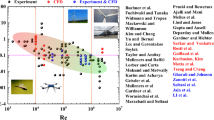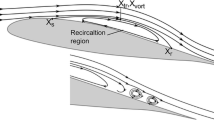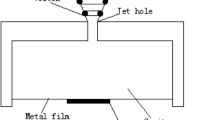Abstract
This paper applies the numerical simulation techniques based on the generalized conservation of circulation (GCC) method to investigate the effects of momentum injection by a leading-edge moving surface on flow past a two-dimensional aerofoil at a Reynolds number of 1000. The stream function and vorticity contours obtained together with the animated flow visualization show that the stall flow region is highly unsteady and consist mainly of large vortices being shed alternately. They are confined to a narrow region near the upper surface of aerofoil asC u (the ratio of the speed of the moving surface to the free stream velocity) is raised. The proximity of vortices to the upper surface of aerofoil at highC u is caused by the ability of free stream to negotiate around the leading edge since the leading-edge moving surface suppresses the growth of boundary layer by reducing the relative between the inviscid flow and the wall. As well-formed large scale vortices are associated with low pressure regions, their proximity to the aerofoil leads to increase in lift as speed ratio increases
Similar content being viewed by others
References
Alvarez-Calderon, A. and Arnold, F. R., A Study of the Aerodynamic Characteristics of a High Lift Device Based on Rotating Cylinder Flap, Stanford University Technical Rept. RCF-1, 1961.
Brooks, J. D., Effect of a rotating cylinder at the leading and trailing edges of a hydrofoil, U.S. Naval Ordnance Test Station, Department of the Navy, NAVWEPS Rept. 8042, April 1963.
Chew,Y. T., Pan, L. S. and Lee, T. S. Numerical simulation of the effect of a moving wall on separation flow past a symmetrical aerofoil, J. Power & Energy, (1998), V212, Part A, 69–77.
Chang, P. K., Control of Flow Separation, (1970), 154–177, Hemisphere Publish Corporation, McGraw-Hill Book Company, Washington.
Favre, A., Contribution a L’etude Experimentale des Mouvement Hydrodynamiques a Deux Dimensions, (1938), Thesis University of Pais.
Goldstein, S., Modern Developments in Fluid Mechanics, (1938), Vols. I and II, Oxford University Press, Oxford, England.
Lachmann, G. V., Boundary-Layer and Flow Control, Its Principles and Application, Vol. I, (1961), pp. 1–2, Pergamon Press, New York.
Modi, V. J. Moving Surface Boundary Layer Control: A Review. J. Fluids and Structures, 11, (1997), 627–663.
Modi, V. J., Sun, J. L. C., Akutsu, T., Lake, P., McMillan, K., Swinton, P. G. and Mullins, D., Moving surface boundary layer control for aircraft operation at high incidence, Journal of Aircraft, 18, (1981), 963–968.
Modi, V. J., Ying, B. and Yokomizo, T., Boundary-layer control of bluff bodies through momentum injection, SAE Trans.:, Journal of Commercial vehicles, Sec. 2, 99, (1990),778–794.
Modi, V. J., Fernando, M. S. U. K. and Yokomizo, T., Moving surface boundary-layer control: Studies with bluff bodies and application, AIAA Journal, 29-9, (1991), 1400–1406.
Munshi,S. R., Aerodynamics and dynamics of bluff bodies in presence of the moving surface boundary-layer control, (1995), Ph.D Thesis, The University of British Columbia.
Pan, L. S., Chew, Y. T. and Lee, T. S., A proposed new vortex calculation method using generalized conservation of circulation model, Proceedings of 6th Asian Congress of Fluid Mechanics (Singapore), (1995), Vol. 1, 445–448, Published by Centre for Continuing Education, Nanyang Technological University.
Rosenhead, L., Laminar Boundary Layers, (1996), 111, 322–335, 547, Clarendon Press, Oxford.
Schlichting, H., Boundary Layer Theory, (1968), 362–390, McGraw-Hill Book Company, New York.
Steele, B. N. and Harding, M. H., The Application of Rotating Cylinder to Ship Maneuvering, National Physical Laboratory, Ship Division, U.K., Report No.148, December 1970.
Tennant, J. S., A subsonic diffuser with moving walls for boundary-layer control, AIAA Journal, 11-2, (1973), 240–242.
Tennant, J. S., Johnson, W. S. and Krothapalli, A., Rotating cylinder for circulation control on an aerofoil, Journal of Hydronautics, 10-3, (1976), 102–105.
Tennant, J. S., Johnson, W. S. and Keaton, D. D., On the calculation of boundary layer along rotating cylinder, Journal of Hydronautics, 11-2, April (1977), 61–63.
Tennant, J. S., Johnson, W. S. and Keaton, D. D., Boundary layer flow from fixed to moving surfaces including gap effects, Journal of Hydronautics, 12-2, (1978), 81–84.
Author information
Authors and Affiliations
Additional information
Author Profile Y. T. Chew: He has received his BEng (Hons.) and MEngSc degrees from the University of Western Australia, and his PhD degree from Cambridge University in 1976. He worked as a Visiting Assistant Professor with the University of Texas at Austin and Southern Methodist University at Dallas, USA briefly before joining the National University of Singapore where he is currently the Professor and Head of the Fluid Mechanics Division. He is also the President of the Institution of Engineers Singapore. His research interests include near-wall turbulence measurements, bluff body aerodynamics, bio-fluid dynamics and computational fluid dynamics.
T. S. Lee: Currently, Deputy Head — Fluid Mechanics Division and Associate Professor, Mechanical Engineering Department, National University of Singapore. He graduated from the University of New South Wales with BE (Hons.) and PhD. He is a senior member of the American Institute of Aeronautics and Astronautics; members of the American Society of Mechanical Engineers, Royal Institution of Naval Architects (UK), Institution of Engineers (Australia), Institution of Engineers (Singapore), Environmental Engineering Society of Singapore and Society of Automobile Engineering (USA). He is a Chartered Engineer (UK) and a Chartered Professional Engineer (Australia). His current research interest is in the areas of Computational Fluid Mechanics.
W. P. Li received his Bachelor’s and Master’s degree from Hua Zhong University of Science and Technology, Wuhan, China in 1982 and 1984 respectively. He graduated from Tianjin University with a PhD degree in 1988. His research interest comprises experimental and numerical methods in hydrodynamics.
L. S. Pan received his Bachelor and Master’s degree from Hua Zhong University of Science and Technology, Wuhan China in 1982 and 1984. He graduated from the National University of Singapore with a PhD degree in 1977. His current research interests include LES and DNS computational methods and the use of Direct Simulation Monte Carlo (DSMC) methods on molecular dynamics.
Y. T. Ng: He has received his B.Eng (Hons.) from the National University of Singapore in 1998. He proceeded to graduate study and conducted research on bluff body flows. Using numerical simulation and different experimental flow visualisation techniques, he studied the flow structures in square cylinder flows, placed at different angles of incidence. His current research interest includes bluff body and high angle of attack aerodynamics and computational fluid dynamics.
Rights and permissions
About this article
Cite this article
Chew, Y.T., Lee, T.S., Li, W.P. et al. Numerical flow visualization of stall suppression of a symmetrical aerofoil by leading-edge moving durface. J Vis 3, 245–252 (2000). https://doi.org/10.1007/BF03181847
Received:
Revised:
Issue Date:
DOI: https://doi.org/10.1007/BF03181847




